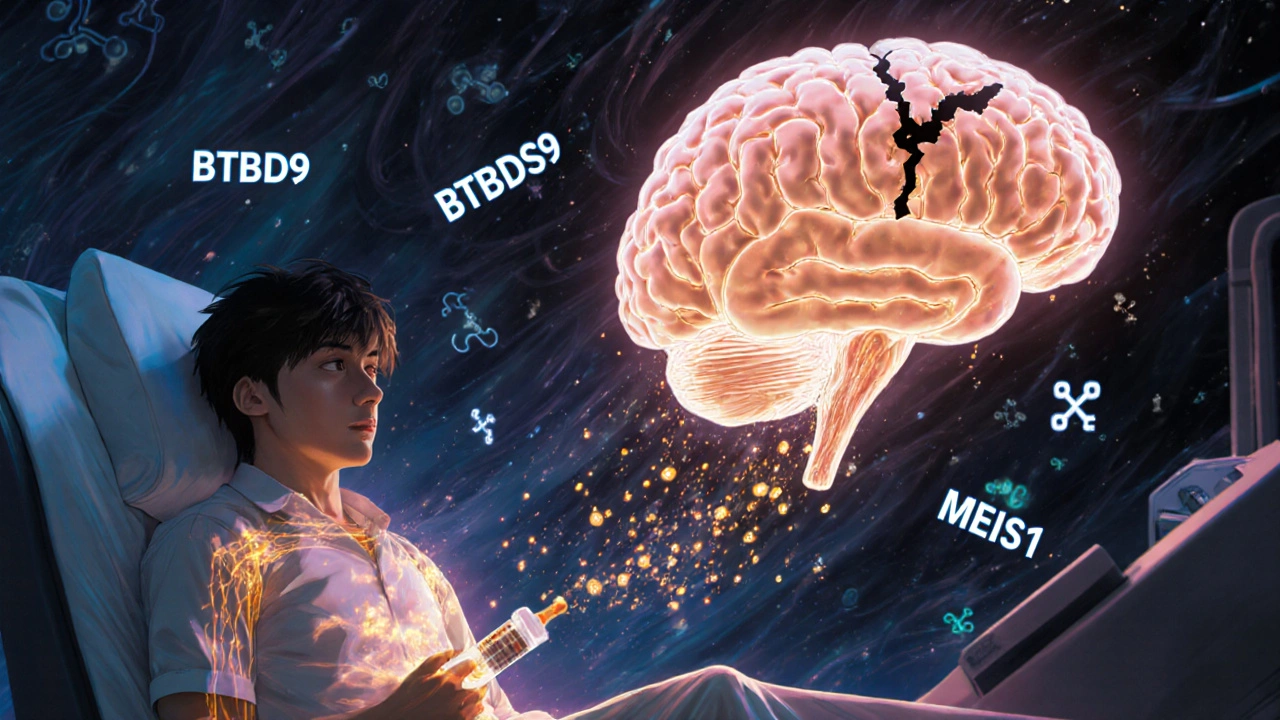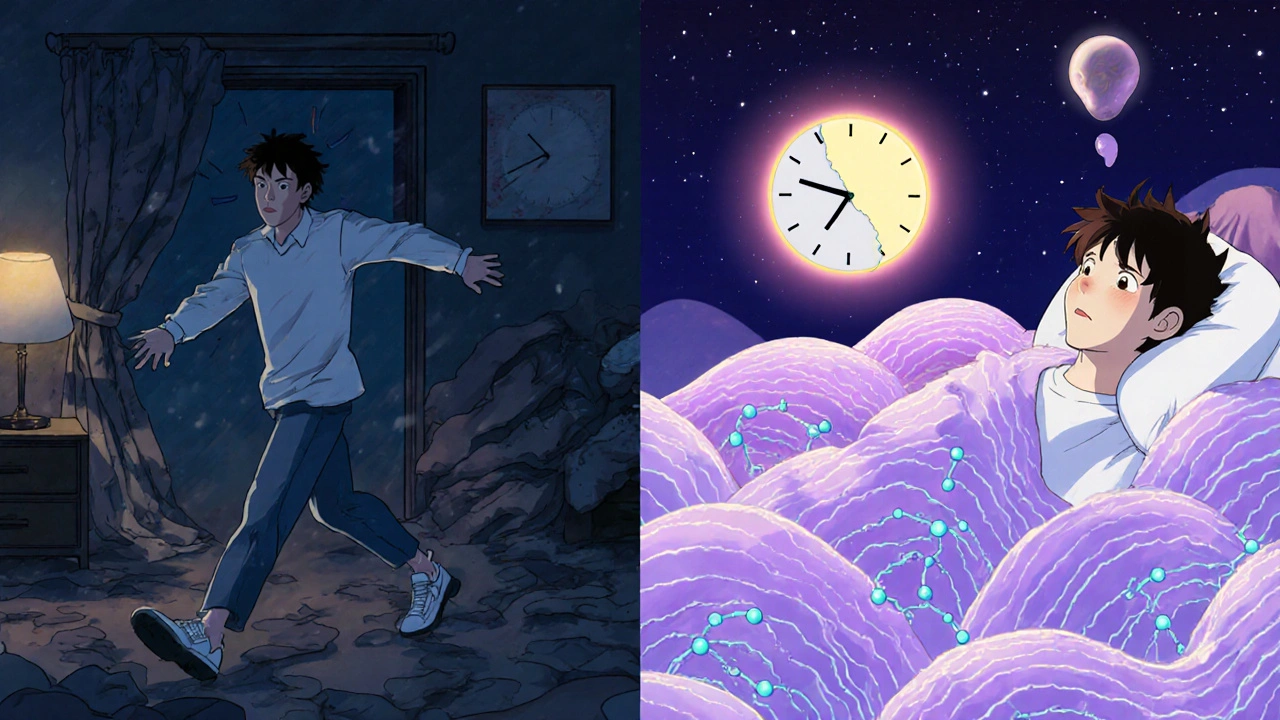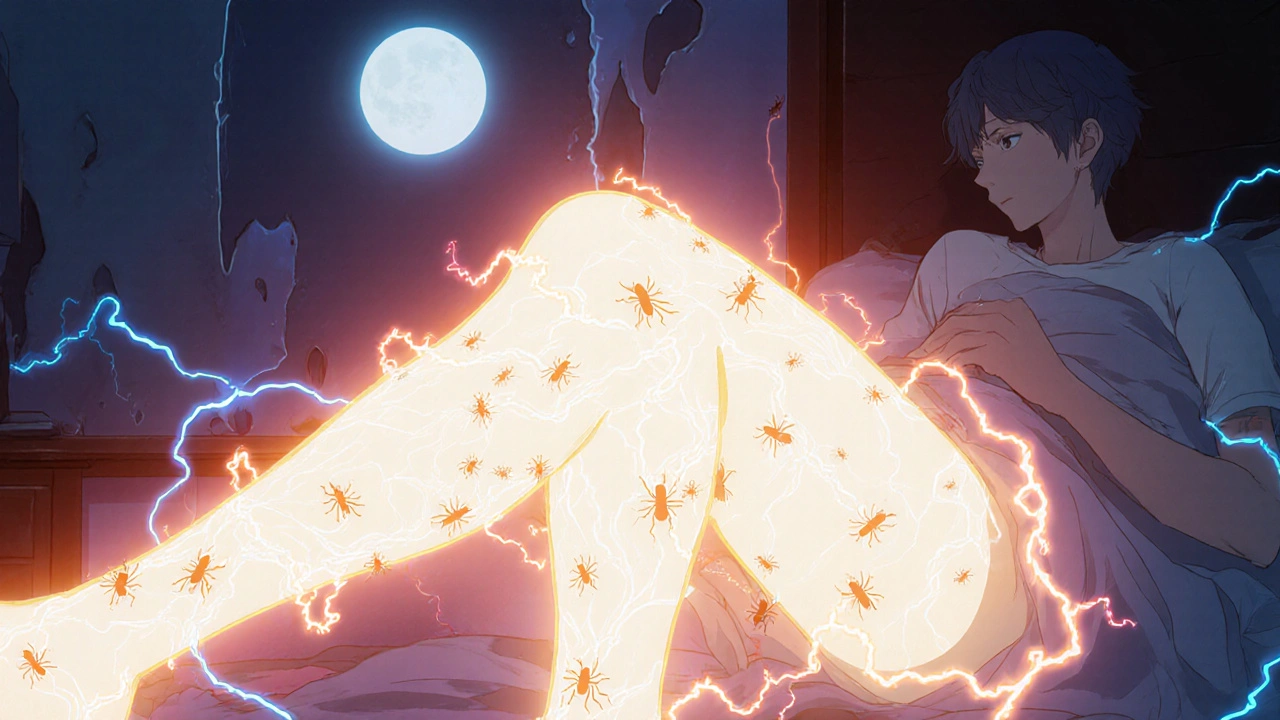Imagine lying in bed, completely still, but your legs feel like they’re crawling with ants, burning, or tingling. The only thing that helps? Moving them. Not just shifting position - you need to get up, pace, stretch, anything to make the sensation go away. And it only gets worse at night. This isn’t insomnia. It’s restless legs syndrome - a neurological condition that hijacks your ability to rest, even when your body is exhausted.
What Restless Legs Syndrome Really Feels Like
Restless legs syndrome, also called Willis-Ekbom disease, isn’t just discomfort. It’s an overwhelming, almost painful urge to move your legs that strikes during quiet moments - sitting still on the couch, watching TV, or trying to fall asleep. The sensations vary: some describe it as electric shocks, others as deep aching or a feeling like bugs are crawling under the skin. It’s not muscle cramps. It’s not poor circulation. It’s a brain signal gone wrong. About 1 in 10 adults in the U.S. has this condition, according to Henry Ford Health. For many, it’s mild. But for others, it’s debilitating. Polysomnography studies show people with RLS lose 30-50% of their total sleep time. They spend more time in light sleep (N1 and N2 stages) and less in deep, restorative sleep. The result? Constant fatigue, trouble concentrating, and a higher risk of car accidents - studies show a 2.3 times greater chance of crashing. Symptoms follow a strict daily pattern. They start or get worse after 8 p.m., peaking between midnight and 2 a.m. That’s why so many people with RLS say they don’t just have trouble falling asleep - they can’t stay asleep. The body moves involuntarily too. Around 80-90% of people with RLS also have periodic limb movements during sleep - sudden jerks every 20-40 seconds, sometimes 100 times an hour. These aren’t dreams. They’re neurological glitches.Why Dopamine Is at the Heart of RLS
The brain’s dopamine system controls movement, reward, and sleep-wake cycles. In RLS, something goes wrong in the A11 dopaminergic neurons - the ones that send signals from the brain down to the spinal cord. Brain scans show a 20-30% drop in dopamine transporter density in the striatum of RLS patients compared to healthy people. That means dopamine isn’t being recycled or used properly. There’s also a strong link to iron. The substantia nigra, a key area for dopamine production, often has low iron levels in people with RLS. Iron is needed to make dopamine. So even if the brain is making enough, without iron, it can’t use it. That’s why checking ferritin levels (a marker of stored iron) is now standard in diagnosis. If your ferritin is below 75 ng/mL, iron therapy can help - sometimes dramatically. This dopamine-iron connection explains why RLS runs in families. Genes like BTBD9 and MEIS1 affect how the brain handles dopamine and iron. People with these variants are more likely to develop RLS and respond differently to treatment.Dopaminergic Therapy: The Go-To Treatment - and Its Hidden Costs
Because dopamine is broken, doctors turn to drugs that boost it. Three FDA-approved dopamine agonists are used: ropinirole (Requip), pramipexole (Mirapex), and rotigotine (Neupro). They all target D3 receptors, which are heavily involved in leg movement control. These drugs work fast. Most people feel relief within an hour. In clinical trials, ropinirole at 4 mg daily cut symptoms by 47% - nearly double the placebo effect. Pramipexole and rotigotine show similar results. For many, it’s life-changing. One patient on Drugs.com wrote: “After 15 years of sleepless nights, I finally slept through the night.” But there’s a catch. Long-term use can make RLS worse. That’s called augmentation. Instead of symptoms happening only at night, they start earlier - maybe at noon. They spread to your arms. They get stronger. You need higher doses just to get the same relief. Studies show 20-70% of patients develop augmentation after one year. Pramipexole has the highest risk - up to 66% after three years. Rotigotine, the skin patch, has the lowest at 26%. Why does this happen? The brain adapts. Constant stimulation from the drug makes dopamine receptors less sensitive. The system becomes dependent. Higher doses don’t fix it - they accelerate the problem. There’s another risk: impulse control disorders. About 6-17% of people on these drugs develop compulsive behaviors - gambling, shopping, binge eating, or hypersexuality. One woman reported $20,000 in credit card debt from uncontrollable shopping. The FDA requires a black box warning for these risks on all dopamine agonists since 2016.
Alternatives to Dopamine Drugs
Because of augmentation and side effects, experts now recommend starting with other options - especially if symptoms happen daily. Alpha-2-delta ligands like gabapentin enacarbil and pregabalin are becoming first-line treatments. They don’t touch dopamine. Instead, they calm overactive nerves. In a 2021 JAMA Neurology trial, pregabalin worked just as well as pramipexole at reducing symptoms - but only 8% of patients developed augmentation versus 32% on the dopamine drug. The downside? They take weeks to work. You can’t just take one pill and feel better. But for chronic RLS, that’s worth it. They also don’t cause impulse control issues. Iron therapy is another key tool - but only if you’re deficient. If your ferritin is under 75 ng/mL, an IV iron infusion (like ferric carboxymaltose) can improve symptoms by 30-40%. It’s not quick. It takes months. But for those who respond, it’s a game-changer. Some stop needing pills entirely. Lifestyle changes matter too. Avoiding caffeine, alcohol, and nicotine helps. Moderate exercise in the afternoon can reduce symptoms. But intense workouts late at night? That can make things worse.How to Use Dopaminergic Therapy Safely
If you do need dopamine agonists, use them wisely. Start low. Ropinirole at 0.25 mg, pramipexole at 0.125 mg - taken 1-3 hours before bedtime. Don’t go higher than 4 mg for ropinirole or 0.5 mg for pramipexole. Higher doses increase augmentation risk without better results. Track your symptoms. Use a daily journal. Note when symptoms start, how bad they are (on a scale of 0-10), and if they’ve spread to your arms or started earlier in the day. A 2022 study found 83% of augmentation cases were caught within three months using this method. Talk to your doctor every 3-6 months. Don’t wait until you’re taking double the dose and symptoms are all day. Early detection saves you from a downward spiral. Mayo Clinic found that patients who understood augmentation signs had 40% better outcomes. Knowledge is power.
The Future of RLS Treatment
New drugs are coming. A new extended-release version of ropinirole (Requip XL) showed a 18% augmentation rate at 12 months - much better than the 31% with the old version. Fipamezole, an alpha-2 adrenergic antagonist, is in Phase II trials and reduced augmentation by 35% compared to pramipexole. Intranasal apomorphine is being tested for rapid, short-term relief without long-term exposure. Genetics may soon guide treatment. The RLS Pharmacogenetics Consortium found they could predict who would respond to pramipexole with 72% accuracy based on BTBD9 and MEIS1 gene variants. Soon, we might test your DNA before prescribing. Right now, dopamine agonists are still essential - especially for severe, intermittent RLS. But they’re not the only option. And for daily symptoms? Alpha-2-delta ligands are safer. Iron therapy can be curative for those with low ferritin. The goal isn’t just to suppress symptoms - it’s to treat the root cause without making things worse.What Patients Are Saying
A Reddit user named u/SleeplessInSeattle posted: “After 8 months on pramipexole, my symptoms started at noon. I couldn’t sit still at work. I had to quit my job.” That’s augmentation. It’s real. It’s common. But there are success stories too. One woman on Healthgrades said: “I switched to pregabalin. No more late-night pacing. I’m sleeping 7 hours for the first time in 10 years.” Across 1,247 patient reviews, 65% of long-term dopamine users eventually switched to non-dopamine drugs because of side effects. Pregabalin was the top choice.Final Thoughts
Restless legs syndrome isn’t just about leg discomfort. It’s a neurological disorder that steals sleep, drains energy, and can change your life. Dopaminergic therapy works - fast and effectively. But it’s a double-edged sword. Augmentation and impulse control disorders aren’t rare side effects. They’re predictable risks. The best approach? Start with iron testing and lifestyle changes. If symptoms are daily, try pregabalin or gabapentin enacarbil first. Reserve dopamine agonists for intermittent cases or when other treatments fail. Monitor closely. Don’t wait until it’s too late. RLS doesn’t have to control your nights. But treating it blindly will. Knowledge, monitoring, and smart choices make all the difference.Can restless legs syndrome be cured?
There’s no cure for RLS, but symptoms can be managed effectively - sometimes even eliminated. For people with low iron levels, IV iron therapy can resolve symptoms entirely. Others find lasting relief with alpha-2-delta ligands like pregabalin. Dopamine agonists help but rarely provide permanent relief without side effects. Long-term control depends on identifying triggers and choosing the right treatment strategy.
Do dopamine medications make RLS worse over time?
Yes, they can. This is called augmentation - when symptoms start earlier in the day, spread to other body parts, or become more intense. Up to 70% of people on dopamine agonists like pramipexole develop augmentation after a few years. Rotigotine has a lower risk, but it still happens. That’s why doctors now recommend these drugs only for occasional symptoms, not daily use.
How do I know if I have low iron causing my RLS?
Your doctor can check your serum ferritin level with a simple blood test. If it’s below 75 ng/mL, low iron is likely contributing to your RLS. Even if your hemoglobin is normal, low ferritin can still cause symptoms. Iron supplements often don’t help enough - IV iron infusions are more effective and recommended by the European Academy of Neurology for ferritin under 75.
What’s the best non-drug treatment for RLS?
Start with iron testing and correction if needed. Then focus on sleep hygiene: keep a regular sleep schedule, avoid caffeine and alcohol after noon, and do light to moderate exercise in the afternoon. Avoid intense workouts late at night. Some people benefit from leg massages, warm baths, or compression socks. Avoiding nicotine and managing stress also helps reduce symptom frequency.
Why do RLS symptoms get worse at night?
The exact reason isn’t fully understood, but it’s tied to the body’s natural dopamine rhythm. Dopamine levels naturally drop in the evening, and RLS is linked to dopamine dysfunction. Iron levels in the brain also follow a circadian pattern, with lower availability at night. Combined with inactivity during rest, this creates the perfect storm for symptoms to peak between 8 p.m. and midnight.
Can I take dopamine agonists only when I need them?
Yes - and that’s actually the safest way to use them. Dopamine agonists are best for intermittent RLS - symptoms that happen less than three times a week. Taking them only on nights you expect symptoms reduces the risk of augmentation. Daily use increases the chance of your body adapting and making symptoms worse. Always follow your doctor’s dosing schedule - never take more than prescribed.
Are there any new treatments on the horizon?
Yes. A new extended-release form of ropinirole (Requip XL) reduces augmentation risk by stabilizing drug levels. Fipamezole, a non-dopamine drug, is in late-stage trials and shows promise with fewer side effects. Intranasal apomorphine offers fast relief without long-term exposure. Genetic testing may soon help predict who responds best to which drug. The goal is to move away from dopamine-dependent treatments and toward safer, targeted therapies.

